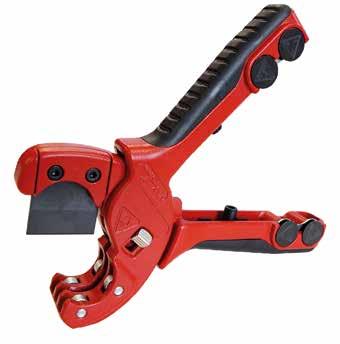
2 minute read
WIN
heat-loss calculations are important, especially in rooms like bathrooms where floor space otherwise used for heating may be taken up by baths and showers.
The right time to install
It’s sometimes best to install systems during a renovation or new construction. However, underfloor heating can be retrofitted when you use overlay systems, which are relatively easy to install and connect to the heat source.
Using a dry system means that you do not need to pour a wet screed over the pipework. It’s a popular choice for retrofit projects because it can be fitted quickly, adding robust, high-density polystyrene boards on top of an existing, suitable floor surface, laying the pipe into place and then fitting the new floor covering directly on top.
Foiled boards have a bonded layer of aluminium foil on the upper surface which enhances the transmission of heat across the floor. Non-foiled boards are designed for use with tiles where
Win a Grant UFH pipe cutter

You’ll definitely need the right tools for UFH installations. We’ve teamed up with Grant UK to offer five readers the chance to win a Grant UK UFH pipe cutter. For your chance to win, simply answer the following question correctly: What are the two common types of underfloor heating system?
a) Wet and windy b) Wet and electric c) Wet and wild adhesive is used. Whichever type of board is used, the system is designed to transfer the heat effectively from the underfloor heating system into the room.
Send your answer plus your name, address and registration number to: competition@registeredgasengineer.co.uk Please include “Grant competition” in the subject line. Five winners will be chosen at random from all correct entries received by the closing date of 31 March 2023.
Usual competition T&Cs apply (see page 43).
What’s the difference between wet and electric?
Wet systems involve running water through pipes under the floor, while electric systems use electric heating elements. Always engage a competent person to handle the electrical work. This is important for ensuring that the system is installed safely and that it’s wired properly.
Get some training
Remember that some electric systems won’t be suitable in certain applications and the same applies to wet systems – do your research, consult the Building Regulations and the manufacturer’s advice and instructions.
Choose a suitable heat source
This can include a boiler, heat pump or other technologies such as solar panels. Make sure the heat source you choose is compatible with your UFH system and that it can provide enough heat to keep the home warm. ■ www.grantuk.com/professional
Many manufacturers now offer training on their UFH products, often free of charge. You can access Grant UK’s course, for instance, via its eLearning Academy. The course is approximately 20 minutes long and has been developed to help installers further their knowledge, covering core components and accessories as well as controls and wiring centres.





